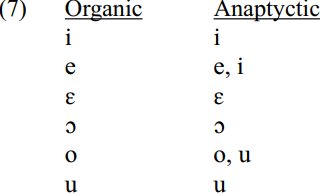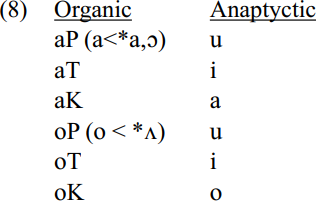


 Grammar
Grammar
 Tenses
Tenses
 Present
Present
 Past
Past
 Future
Future
 Parts Of Speech
Parts Of Speech
 Nouns
Nouns
 Verbs
Verbs
 Adverbs
Adverbs
 Adjectives
Adjectives
 Pronouns
Pronouns
 Pre Position
Pre Position
 Preposition by function
Preposition by function 
 Preposition by construction
Preposition by construction
 Conjunctions
Conjunctions
 Interjections
Interjections
 Grammar Rules
Grammar Rules
 Linguistics
Linguistics
 Semantics
Semantics
 Pragmatics
Pragmatics
 Reading Comprehension
Reading Comprehension|
Read More
Date: 2023-09-28
Date: 2024-05-21
Date: 2024-04-20
|
The CHOICE set of words, corresponding to ME /ɔi, ʊi/ , is represented in Suriname creoles by words derived from Early Modern English boy, boil (n.), boil (v.), and spoil. According to Dobson (1957) the /ɔi/ found in modern Standard English is derived from one ME variant, alternating in many words with /ʊi/ which later became /ai/ (< /´i/) in advanced pronunciation in EModE.

The forms for boy are not (necessarily) problematic, but those for the other three words are. The reason is the unusual combination of organic and anaptyctic vowels here. Usually, features of the organic vowel are repeated in the anaptyctic vowel:

or, as in the case of low vowels, the final consonant plays a role:

Here, however, the diphthong /ɔi/ gives us /o-i/. The other two diphthongs in English /ai/ and /au/ result in /e-i, e-e/ and /o-u, o-o/ respectively. In other words diphthongs are generally compressed to single vowels, of forecastable quality. /e/ reflects the features of both /a/ and /i – low] and [front], and /o/ the features of both /a/ and /u – low] and [round]. But, the /o/ in /bo’ri/ does not reflect both the features of /ɔ/ and the features of /i/. We must look further.
Let us start from the anaptyctic vowel /-i/. This implies in general a front organic vowel. We ignore the fact that coronal consonants following organic historic low vowels trigger anaptyctic /-i/ because we expect the three English diphthongs to be treated in a parallel fashion. As Smith (1987: 432) observes “The only case that would fit the occurring patterns would be a model involving the EModE vowel /Λ/ followed by an alveolar”. Why /ɔi/ should result in /Λ/ is not at all clear. It is of course the case that the CHOICE set has fallen together with the STRUT set.
Rounded vowels do have another source in the Suriname creoles than English back or round vowels. We find not infrequent cases of the following (unsystematic) changes:

Further, in these cases the comparison drawn with Krio and Jamaican by Smith (1987) is illuminating:

If the diphthongs in the cases with codas were preceded historically by a situation like that in Krio, then the anaptyctic front vowels can be explained. This is then due to the organic front vowel present. Note that Krio, like the Suriname creoles, systematically compresses pre-coda diphthongs /ai, au/ into single vowels. We could then imagine a derivational path as follows:

Where does this vocalic structure /wai/ come from? Presumably from EME /ʊi/. On the evidence of Wright (1905) [wai] and [wəi] only occur after labials. Dobson (1957: 825) compares the retention of /ʊi/ here to the parallel tendency to retain /ʊ/ after labials. The intermediate stages he posits are of lesser interest so we will ignore Dobson’s further discussion here.
|
|
|
|
تفوقت في الاختبار على الجميع.. فاكهة "خارقة" في عالم التغذية
|
|
|
|
|
|
|
أمين عام أوبك: النفط الخام والغاز الطبيعي "هبة من الله"
|
|
|
|
|
|
|
قسم شؤون المعارف ينظم دورة عن آليات عمل الفهارس الفنية للموسوعات والكتب لملاكاته
|
|
|